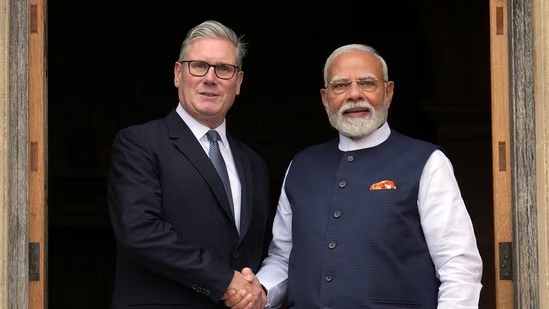In a significant boost to India’s military modernization and its growing defence ties with the United Kingdom, a £350 million ($468 million) contract has been signed to supply the Indian Army with advanced lightweight missiles. This deal, finalized in early October 2025, enhances the Army’s short-range strike capabilities, particularly for rapid-response units operating in diverse terrains, from Himalayan borders to urban theatres. As India pushes for self-reliance under Atmanirbhar Bharat, this agreement also opens doors for co-production and technology transfers, cementing Indo-UK strategic collaboration at a time of heightened regional tensions.
Strengthening the Indo-UK Defence Corridor
The missile deal follows a series of high-level engagements between New Delhi and London, including the UK’s recent upgrades to its ageing missile stockpiles and India’s interest in interoperable systems. The lightweight missiles—likely variants of the UK’s proven Starstreak or Lightweight Multirole Missile (LMM)—offer high precision, portability, and rapid deployment, ideal for India’s Special Forces and mechanized units. Weighing under 20 kg per unit, these systems can be shoulder-launched or integrated into vehicles like the Zorawar Light Tank, enhancing mobility against low-flying threats like drones, helicopters, or ground targets up to 7-8 km away.
Signed under the aegis of the India-UK Comprehensive Strategic Partnership, the contract includes 1,200-1,500 missile units, with deliveries starting Q2 2026. The agreement was facilitated by the UK’s Defence Equipment & Support (DE&S) and India’s Ministry of Defence (MoD), with Thales UK as the primary supplier. Beyond procurement, the deal outlines a framework for joint R&D, with Indian firms like Bharat Dynamics Limited (BDL) exploring licensed production to achieve 50%+ indigenous content by 2028. This aligns with India’s goal of reducing import dependency while leveraging UK expertise in high-speed missile technology.
Technical and Operational Advantages
The lightweight missiles boast advanced guidance systems (laser beam-riding or infrared homing), ensuring a hit probability exceeding 90% against agile targets. Their compact design suits India’s operational needs in high-altitude regions like Ladakh, where mobility is critical against China’s expanding drone fleet. Compared to India’s existing Akash SAM systems, these missiles offer shorter reaction times (under 5 seconds from launch to impact) and lower logistical footprints, making them ideal for forward-deployed units.
| Feature | Specification/Details |
|---|---|
| Type | Lightweight Surface-to-Air/Ground Missile |
| Weight | <20 kg per unit |
| Range | 1-8 km |
| Speed | Mach 3+ |
| Guidance | Laser beam-riding or IR homing |
| Payload | High-explosive fragmentation |
| Platforms | Man-portable, vehicle-mounted (e.g., Zorawar Tank, LCH Prachand) |
| Key Advantage | Anti-drone, anti-helicopter, rapid deployment |
| Delivery Schedule | Q2 2026 – Q4 2027 |
This acquisition complements India’s indigenous missile programs, such as the Akash-NG and QRSAM, by filling a niche for lightweight, short-range systems. It also counters Pakistan’s recent drone incursions along the LoC and China’s PLAAF deployments in Tibet, ensuring India’s multi-layered defence architecture remains robust.
Strategic Context: A Win for Atmanirbhar Bharat
The £350 million deal is more than a transaction—it’s a strategic pivot. The UK, seeking to deepen its Indo-Pacific presence post-Brexit, views India as a key partner to counterbalance China’s influence. For India, the partnership strengthens its Western alliances while supporting domestic industry. The MoD has mandated that 30% of the contract value be reinvested in India via offsets, funding local SMEs in electronics and composites. Talks are underway for BDL and Thales to co-develop a next-gen missile variant, potentially exportable to Southeast Asia, mirroring India’s BrahMos success with the Philippines.
This deal also builds on recent Indo-UK defence milestones, including joint exercises like Ajeya Warrior 2025 and the UK’s support for India’s UNSC permanent seat bid. It follows India’s Operation Sindoor, which exposed vulnerabilities in regional air defences, prompting the Army to prioritize versatile, lightweight systems. The missiles will equip units like the 17 Mountain Strike Corps, enhancing deterrence along the LAC.
Looking Forward: Synergies and Opportunities
As deliveries begin in 2026, the Indian Army will integrate these missiles into its networked battlefield systems, leveraging the Indigenous Radio Software Architecture (IRSA) for real-time targeting. The deal’s co-production clause could see India manufacture 60% of components domestically by 2030, creating 1,500-2,000 jobs in Telangana and Maharashtra. For defence enthusiasts, this underscores India’s growing clout in global arms markets, with potential exports to allies like Vietnam or UAE.
Explore More:
Zorawar Light Tank’s Role in High-Altitude Warfare – How these missiles integrate with India’s new armor.
Indra 2025 Strengthens India-Russia Ties – Compare India’s global defence partnerships.
Sources: MoD press releases, UK DE&S announcements, and industry reports as of October 11, 2025.
DefenceNiti.com: Empowering India’s Defence Awareness | #AtmanirbharBharat #IndiaUKDefence #IndianArmy




Pingback: Post-Op Sindoor, Pakistan builds underground airbases to shield PAF assets - DefenceNiti.com
Pingback: DRDO’s LODN: Indigenous optical network detects stealth threats up to 250 km - DefenceNiti.com
Pingback: IAF-DRDO upgrades S-400 into a networked air defence beast post-Op Sindoor - DefenceNiti.com
Pingback: Project Kusha: India’s indigenous 350 km SAM - DefenceNiti.com
Pingback: India’s Hypersonic Missile Program - DefenceNiti.com
Pingback: India’s Akashteer System - DefenceNiti.com
Pingback: India’s Naval Anti-Ship Missile (NASM) Program - DefenceNiti.com